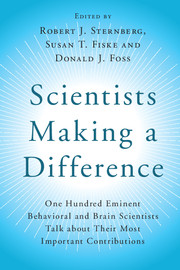 Scientists Making a Difference
Scientists Making a Difference Book contents
- Frontmatter
- Contents
- List of Contributors
- Foreword: Making a Creative Difference = Person × Environment
- Preface
- Part I Introduction
- Part II Biological Bases of Psychology: Genes, Brain, and Beyond
- Part III Cognition: Getting Information from the World and Dealing with It
- Part IV Development: How We Change Over Time
- Section A Cognitive Development
- 40 Building a Unique Network of Scientific Enterprises
- 41 Research on Children's Recollections: What a Difference a Phone Call Made
- 42 Development of Children's Knowledge About the Mind
- 43 Real Representations in Two Dimensions
- 44 Language and the Social Brain: The Power of Surprise in Science
- 45 The Importance of Developmental Plasticity
- 46 Levels of Analysis in Cognitive Aging
- 47 The Longitudinal Study of Adult Cognitive Development
- 48 How Does Change Occur?
- 49 Cognitive Abilities of Infants
- Section B Social/Personality Development
- Part V Motivation and Emotion: How We Feel and What We Do
- Part VI Social and Personality Processes: Who We Are and How We Interact
- Part VII Clinical and Health Psychology: Making Lives Better
- Part VIII Conclusion
- Afterword: Doing Psychology 24×7 and Why It Matters
- Index
- References
49 - Cognitive Abilities of Infants
from Section A - Cognitive Development
Published online by Cambridge University Press: 05 August 2016
- Frontmatter
- Contents
- List of Contributors
- Foreword: Making a Creative Difference = Person × Environment
- Preface
- Part I Introduction
- Part II Biological Bases of Psychology: Genes, Brain, and Beyond
- Part III Cognition: Getting Information from the World and Dealing with It
- Part IV Development: How We Change Over Time
- Section A Cognitive Development
- 40 Building a Unique Network of Scientific Enterprises
- 41 Research on Children's Recollections: What a Difference a Phone Call Made
- 42 Development of Children's Knowledge About the Mind
- 43 Real Representations in Two Dimensions
- 44 Language and the Social Brain: The Power of Surprise in Science
- 45 The Importance of Developmental Plasticity
- 46 Levels of Analysis in Cognitive Aging
- 47 The Longitudinal Study of Adult Cognitive Development
- 48 How Does Change Occur?
- 49 Cognitive Abilities of Infants
- Section B Social/Personality Development
- Part V Motivation and Emotion: How We Feel and What We Do
- Part VI Social and Personality Processes: Who We Are and How We Interact
- Part VII Clinical and Health Psychology: Making Lives Better
- Part VIII Conclusion
- Afterword: Doing Psychology 24×7 and Why It Matters
- Index
- References
Summary
I entered psychology at an exciting time. An extraordinary scientist, Eleanor Gibson, had shown that a capacity for visual depth perception is innate: It is present and functional on first encounters with a visible environment.
Gibson, one of my two graduate advisors, thus settled a longstanding question concerning the development of perception, and she raised a broader possibility concerning the development of knowledge. Do infants not only perceive where surfaces are, but also what they are? Do they organize arrays of surfaces into meaningful objects and events?
My other graduate advisor, Ulric Neisser, was one of the founders of the modern field of cognitive psychology. At the time, he was studying the processes by which adults attend selectively and adaptively to events. He and others (especially Anne Treisman and Daniel Kahneman) discovered that attention tends to focus on discrete objects (whether people or things), rather than arrays of surfaces – so much so that if college students are watching a competitive ball game, they follow the players and the ball so well that they may miss a gorilla crossing the room. But are we built to perceive, attend to, and understand objects, or do these abilities develop as we explore objects and observe their behavior? I became fascinated by this question.
One of my first experiments asked whether infants who can't yet manipulate objects have separate or unitary experiences of objects’ associated sights and sounds. To find out, I made simple, short movies of a person playing “peekaboo” and of a hand making a rhythmic pattern with a baton and tambourine. When both movies played side by side and each soundtrack was heard in alternation through a central speaker, four-month-old infants looked primarily at whichever movie currently accompanied the sound. Later studies in other labs showed that infants are exquisitely sensitive to the relations between sound and movement that accompany human speech, and that they detect some relations between sounds and visible objects even at birth. Thus, infants do not simply look and listen to people and things; they relate these separate sensory impressions to one another. But do babies perceive objects as we do? As a new assistant professor, I began to address this question with students in my own lab.
- Type
- Chapter
- Information
- Scientists Making a DifferenceOne Hundred Eminent Behavioral and Brain Scientists Talk about Their Most Important Contributions, pp. 228 - 232Publisher: Cambridge University PressPrint publication year: 2016
